Biscayne Island is a beautiful and natural oasis in the heart of Biscayne Bay in Miami, Florida. This idyllic island paradise is home to diverse bird species, which thrive in its lush vegetation, warm climate, and pristine beaches.
From the majestic osprey to the colorful American Redstart, the birds of Biscayne Island are a sight to behold.
In this article, we will explore some of the most prominent bird species found on Biscayne Island, their unique features, and their importance to the local ecosystem.
24 Common Birds Found Near Biscayne Island
Biscayne Island is a small island in Biscayne Bay, Miami, Florida. It is part of the Venetian Islands, a chain of artificial islands that connect Miami Beach to mainland Miami. Biscayne Island is a residential area with many luxurious homes and condos, but it also offers a natural refuge for many bird species.
The island has a variety of habitats, such as mangroves, palm trees, lawns, and waterfronts, that attract different kinds of birds throughout the year. Whether you are a resident or a visitor, you can enjoy the beauty and diversity of the avian life on Biscayne Island.
Here are 24 common birds that you can find near Biscayne Island.
1. Northern Mockingbird
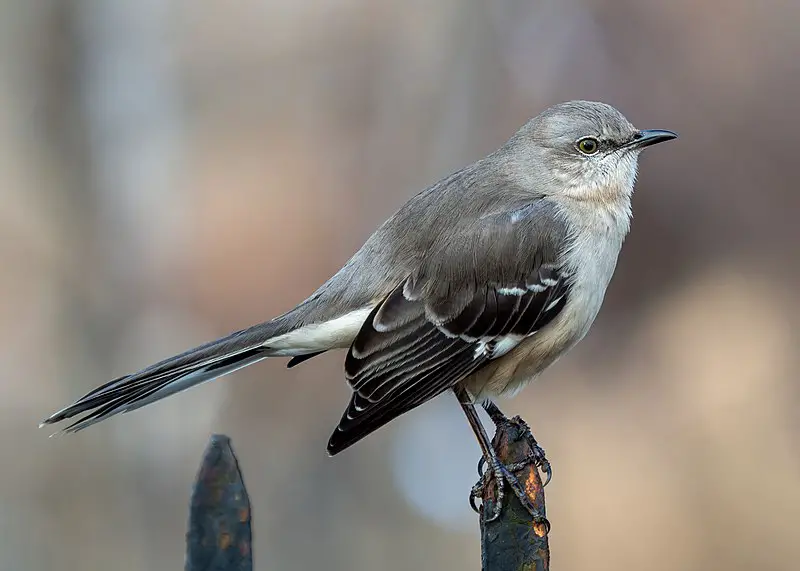
The northern mockingbird is a common fixture in North American skies. It has greyish-brown upperparts and a paler underside with white wing patches, and its distinctive long tail makes it easy to spot.
This adaptable bird can often be seen singing from the tops of trees or fences, though it rarely strays into Europe.
Carl Linnaeus first described the species in his 1758 Systema Naturae as Turdus polyglottos – aptly named for their remarkable ability to mimic other birds’ songs.
Northern mockingbirds typically live on insects, fruits, berries, and seeds, but they will also happily scavenge food scraps left out by humans.
With its beautiful song and striking plumage, this beloved avian contributes to our environment.
Scientific classification:
| Kingdom | Animalia |
| Phylum | Chordata |
| Class | Aves |
| Order | Passeriformes |
| Family | Mimidae |
| Genus | Mimus |
| Species | M. polyglottos |
Also Featured In: Most Common United States Birds, Most Common Winter Birds
2. American Goldfinch
The American goldfinch is a small North American bird in the finch family. Males are vibrant yellow with black wings and tails, while females are duller in coloration.
It migrates from mid-Alberta to North Carolina during the breeding season, south of Canada–United States border to Mexico for its wintering grounds.
The only finch that undergoes complete molt every year displays sexual dichromatism, where males have brighter colors than their female counterparts.
They feed mainly on seeds but also eat insects such as aphids and caterpillars when raising young; they often occur near thistles or other plants that produce viable seed heads.
Their call consists of various chirps and trills, making them quite conspicuous.
Scientific classification:
| Kingdom | Animalia |
| Phylum | Chordata |
| Class | Aves |
| Order | Passeriformes |
| Family | Fringillidae |
| Subfamily | Carduelinae |
| Genus | Spinus |
| Species | S. tristis |
Also Featured In: Most Common Songs Birds that Live around You, Birds That Live in Colorado
3. Common Loon
The Common Loon is a beautiful bird found in North America. It has a large black head and neck, with a greenish to purple sheen that stands out against its dark grey upperparts.
The underparts are white except for some black on the undertail cover and vent.
During the non-breeding season, adults have brown plumage instead of the bright shades they show during the breeding season.
They also exhibit unique behaviors, such as diving underwater to catch fish or swimming along lakeshores while calling loudly, which is how they got their name “great northern diver.”
With their stunning colors and interesting behavior, it’s no wonder why these birds make up an iconic part of many landscapes across North America.
Scientific classification:
| Kingdom | Animalia |
| Phylum | Chordata |
| Class | Aves |
| Order | Gaviiformes |
| Family | Gaviidae |
| Genus | Gavia |
| Species | G. immer |
Also Featured In: Summer Birds that Live around Us, British Columbian Birds
4. Downy Woodpecker
The downy woodpecker is a small species of woodpecker found in North America. Growing up to 7 inches long, it can be identified by its white belly and spotted wings.
It inhabits forests throughout the United States and Canada, except deserts in the southwest and northern tundra.
This bird nests in tree cavities and feeds mostly on insects but will supplement its diet with fruit or nuts when available.
The Downy Woodpecker has an unmistakable call that sounds like a loud ‘piker,’ similar to other members of its family, such as the Hairy Woodpecker.
Scientific classification:
| Kingdom | Animalia |
| Phylum | Chordata |
| Class | Aves |
| Order | Piciformes |
| Family | Picidae |
| Genus | Dryobates |
| Species | D. pubescens |
Also Featured In: Birds Commonly Found in New York, Birds Live in Arkansas
5. House Finch
The House Finch is a finch species native to western North America and has been introduced in the eastern half of the continent and Hawaii.
It’s an average-sized finch with adults measuring 12.5 – 15 cm (5 – 6 inches) long and wingspan between 20 – 25 cm (8 – 10 inches).
The upperparts are brown, while its underparts range from pale grayish white to yellow depending on subspecies.
Its face is streaked or spotted with reddish coloration; males typically have brighter plumage than females due to sexual dimorphism.
They’re mostly found near human habitations such as farms and gardens, where they feed on grains, fruits, insects, etc., making them very popular among birders who want something colorful for their backyard.
Scientific classification:
| Kingdom | Animalia |
| Phylum | Chordata |
| Class | Aves |
| Order | Passeriformes |
| Family | Fringillidae |
| Subfamily | Carduelinae |
| Genus | Haemorhous |
| Species | H. mexicanus |
Also Featured In: Birds Live Near San Diego, Common Birds in the Cities
6. Belted Kingfisher
The belted kingfisher is a large, eye-catching bird native to North America. It belongs to the family Alcedinidae and has been divided into three subfamilies by recent research.
The species was first described in 1758 by Carl Linnaeus in his Systema Naturae.
This water Kingfisher stands out for its size and striking plumage; males are bright blue on top with white below, and females have rusty brown backs and wings with a thick black breast band across their chest.
They also possess an impressive call that can be heard from quite far away.
Belted kingfishers feed mainly on small fish but sometimes also eat crustaceans, insects, or even amphibians if they come across them while hunting around rivers or streams.
All in all, this is truly one remarkable bird that deserves our admiration.
Scientific classification:
| Kingdom | Animalia |
| Phylum | Chordata |
| Class | Aves |
| Order | Coraciiformes |
| Family | Alcedinidae |
| Subfamily | Cerylinae |
| Genus | Megaceryle |
| Species | M. alcyon |
Also Featured In: Most Popular Bird Species in North America, Common Southern Californian Birds
7. American White Pelican
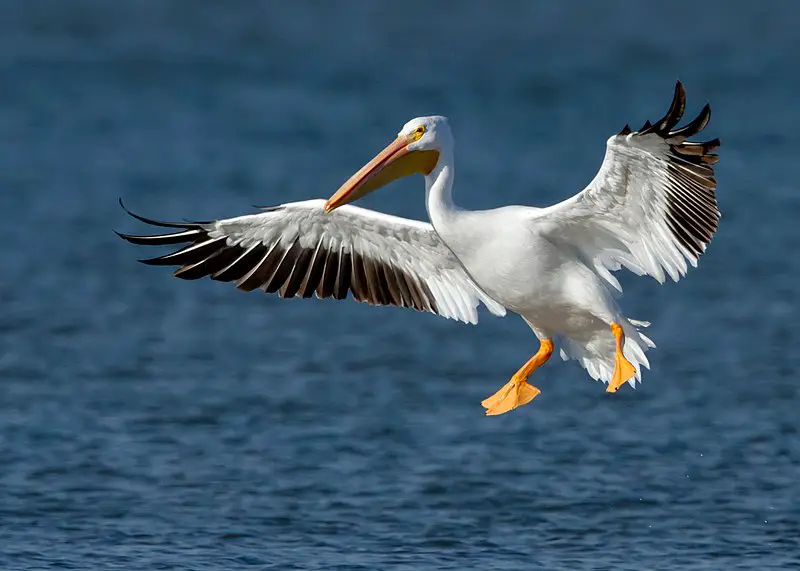
The American White Pelican is a majestic bird from the Pelecaniformes order, known for its impressive size and ability to soar gracefully in the sky.
It breeds during summer months in North America and migrates southwards towards Central and South America during winter.
The species was first described by German naturalist Johann Friedrich Gmelin back in 1789 as part of his updated version of Carl Linnaeus’ work.
This large aquatic bird has an all-white plumage with black primary flight feathers on its wings, while its beak features a characteristic yellowish coloration at the base near the face.
Its diet mainly consists of fish which it typically catches after dipping into water using its long bill; yet sometimes they can be seen stealing food items from other birds such as cormorants or gulls.
Scientific classification:
| Kingdom | Animalia |
| Phylum | Chordata |
| Class | Aves |
| Order | Pelecaniformes |
| Family | Pelecanidae |
| Genus | Pelecanus |
| Species | P. erythrorhynchos |
Also Featured In: Birds You’ll Find in South Texas , Birds that Live around Central Florida
8. Gray Catbird
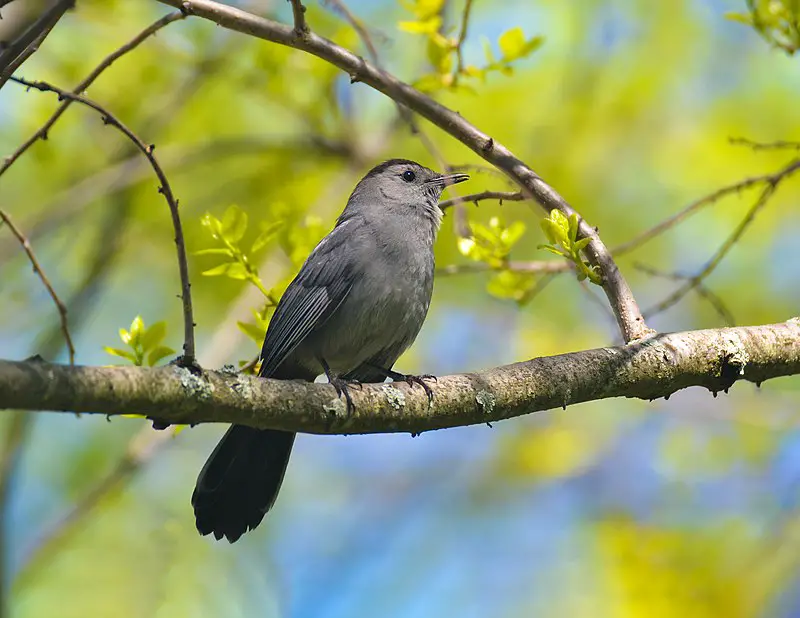
The Gray Catbird is a medium-sized bird native to North and Central America. It is the only species in its genus, Dumetella, which makes it unique among other perching birds of the Mimidae family.
Its plumage features shades of gray with some brownish tones on top and lighter grey below.
The underside of its tail has white feathers contrasting against their otherwise monochromatic coloration; this feature gives them their name as they often flick their tails when alarmed or excited as cats do.
They are omnivorous but mainly feed on insects such as caterpillars, grasshoppers, and beetles while eating fruits like berries or cherries during summer.
Despite being commonly seen alone or in pairs, these birds will sometimes flock together for protection from predators like hawks, who are drawn to their dark coloration against green foliage, making them harder to spot.
Scientific classification:
| Kingdom | Animalia |
| Phylum | Chordata |
| Class | Aves |
| Order | Passeriformes |
| Family | Mimidae |
| Genus | Dumetella C.T. Wood, 1837 |
| Species | D. carolinensis |
Also Featured In: Birds that Migrate through Illinois in the Spring, Common Birds in Saskatchewan
9. Common Grackle

The Common Grackle is a large icterid bird commonly found in North America. It has an iridescent head and pale yellow eyes framed by its long dark bill and long tail.
Males typically have more vivid colors on their heads than females do. These birds can be seen across much of the continent, in fields, forests, wetlands – even urban areas.
They form huge flocks to search for food, such as grains or insects, that they catch with their bills.
If available, the grackles may also scavenge from human sources like garbage dumps or picnic tables. With its colorful plumage and distinct call, spotting this species amongst other birds is easy.
Scientific classification:
| Kingdom | Animalia |
| Phylum | Chordata |
| Class | Aves |
| Order | Passeriformes |
| Family | Icteridae |
| Genus | Quiscalus |
| Species | Q. quiscula |
Also Featured In: Flocks Birds around Us, Central Texas Birds
10. Loggerhead Shrike
The Loggerhead Shrike is a carnivorous bird found only in North America. It belongs to the family Laniidae and is known as the “butcherbird” because of its habit of catching prey, such as amphibians, insects, lizards, and small mammals.
The shrike has a black mask around its eyes and grey wings with white patches on them.
Its back is black with white spots resembling stars or snowflakes; some may have brown feathers instead of black ones.
This species feeds mainly by perching from elevated locations like bushes or trees where it can spot potential meals below it before diving down for capture.
Interestingly, these birds are also known to store their food by impaling it onto thorns, which they use later when hungry.
With an estimated population of less than 2 million left in the wild today, this species needs our help, so we should do whatever we can to protect them better.
Scientific classification:
| Kingdom | Animalia |
| Phylum | Chordata |
| Class | Aves |
| Order | Passeriformes |
| Family | Laniidae |
| Genus | Lanius |
| Species | L. ludovicianus |
Also Featured In: Top Birds Found in Mexico, Common Birds in Alberta
11. Green Heron
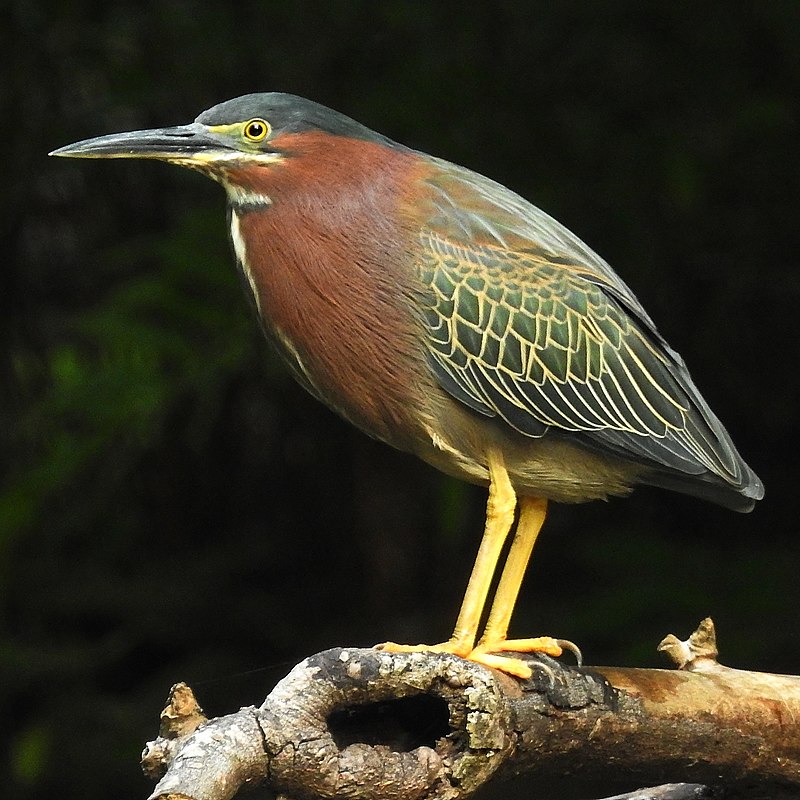
The Green Heron (Butorides virescens) is a small heron throughout North and Central America.
Its scientific name comes from the Middle English ‘butor,’ meaning bittern, combined with the Latin term for its distinctive greenish color – ‘virescens.’
For many years, it was considered part of the same species as the Striated Heron (Butorides striata), commonly referred to as “green-backed herons.”
The nominate subspecies inhabits wetlands across much of this range, where they can be spotted stalking about in shallow water, looking for fish or frogs on which to feed.
They are fascinating wading birds that have even been known to use tools such as sticks or baited lines when fishing.
Scientific classification:
| Kingdom | Animalia |
| Phylum | Chordata |
| Class | Aves |
| Order | Pelecaniformes |
| Family | Ardeidae |
| Genus | Butorides |
| Species | B. virescens |
Also Featured In: Birds that You’ll Find in Puerto Rico, Swamps Birds You Should Know
12. American White Ibis
The American white ibis is a medium-sized bird with white plumage and long legs. It has a bright red-orange downward curved bill and black wing tips, usually only visible in flight.
This species of ibis can be found from Virginia south through most of the coastal New World tropics.
They have been known to inhabit marshes, swamps, ponds, lakeshores, and mangrove forests near water sources where they feed on crustaceans such as crabs and shrimp, among other aquatic animals like insects or snails.
The American white ibis plays an important role in its ecosystem by helping to control insect populations, which helps maintain balance within these environments.
Scientific classification:
| Kingdom | Animalia |
| Phylum | Chordata |
| Class | Aves |
| Order | Pelecaniformes |
| Family | Threskiornithidae |
| Genus | Eudocimus |
| Species | E. albus |
Also Featured In: Everglades Birds, Birds that Live around Southwest Florida
13. Cattle Egret
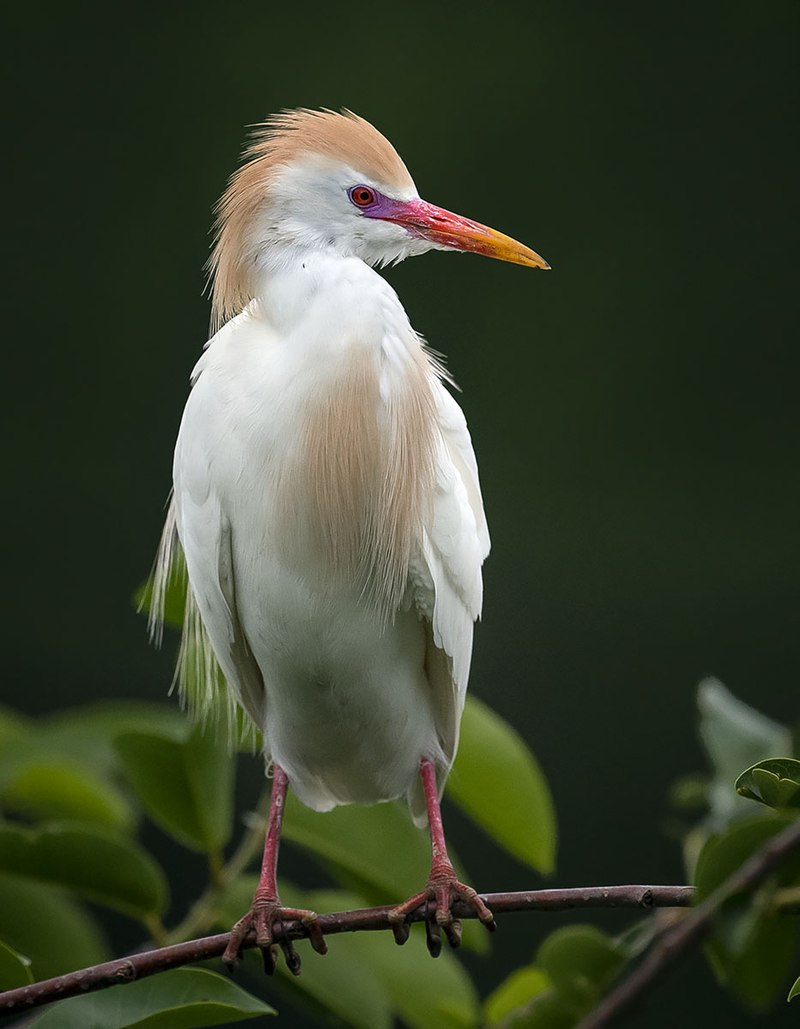
The Cattle Egret is a heron of the family Ardeidae found worldwide in tropical, subtropical, and warm temperate areas. It has two subspecies: western cattle egret and eastern cattle egret.
They have white plumage with buff plumes on their head, neck, and back. The beak is yellowish-orange with a black tip, while the legs are orange or yellow colored depending on species variation.
This bird usually feeds near large herds of animals, such as cows, horses, etc., where it finds plenty of insects, like grasshoppers, crickets, etc.
Its presence benefits these animals by removing ectoparasites from them, which leads to a healthier livestock population.
It nests colonially in trees or shrubs located close to water bodies during breeding season which generally takes place between March-June every year.
Scientific classification:
| Kingdom | Animalia |
| Phylum | Chordata |
| Class | Aves |
| Order | Pelecaniformes |
| Family | Ardeidae |
| Genus | Bubulcus Bonaparte, 1855 |
| Species | B. ibis |
Also Featured In: Egyptian Birds, Asian Birds
14. Great Egret

The Great Egret is a large, white bird found in many regions of the world. It has four subspecies reside across Asia, Africa, the Americas, and southern Europe.
This species usually lives near bodies of water such as lakes and marshes. They are also spreading into more northern areas of Europe due to climate change.
These birds have long yellow legs with an impressive wingspan, allowing them to soar majestically through the sky, hunting for fish or amphibians in shallow waters below.
Their feathers have been used historically by Native Americans as part of traditional garments or ceremonies. Still, this practice should be avoided today so these amazing creatures can thrive without harm from humans.
Scientific classification:
| Kingdom | Animalia |
| Phylum | Chordata |
| Class | Aves |
| Order | Pelecaniformes |
| Family | Ardeidae |
| Genus | Ardea |
| Species | A. alba |
Also Featured In: Most common Birds in France, Most Common Romanian Birds
15. Great Blue Heron
The Great Blue Heron is a majestic wading bird found in many parts of North America, Central America, the Caribbean, and even as far away as the Galapagos Islands.
It has an impressive wingspan which can reach up to six feet wide. Its feathers are mainly bluish-gray with brownish streaks on its neck and chest, while its head displays white plumes.
The adult herons can also be identified by their yellow bill and legs.
They live near bodies of water such as lakes, marshes, or rivers, feeding on fish using a spear-like motion with their sharp bills.
An all-white population exists only in South Florida and the Florida Keys, making it unique.
Scientific classification:
| Kingdom | Animalia |
| Phylum | Chordata |
| Class | Aves |
| Order | Pelecaniformes |
| Family | Ardeidae |
| Genus | Ardea |
| Species | A. herodias |
Also Featured In: Common Birds in Canada, Birds that Live in the Deserts
16. Black Vulture
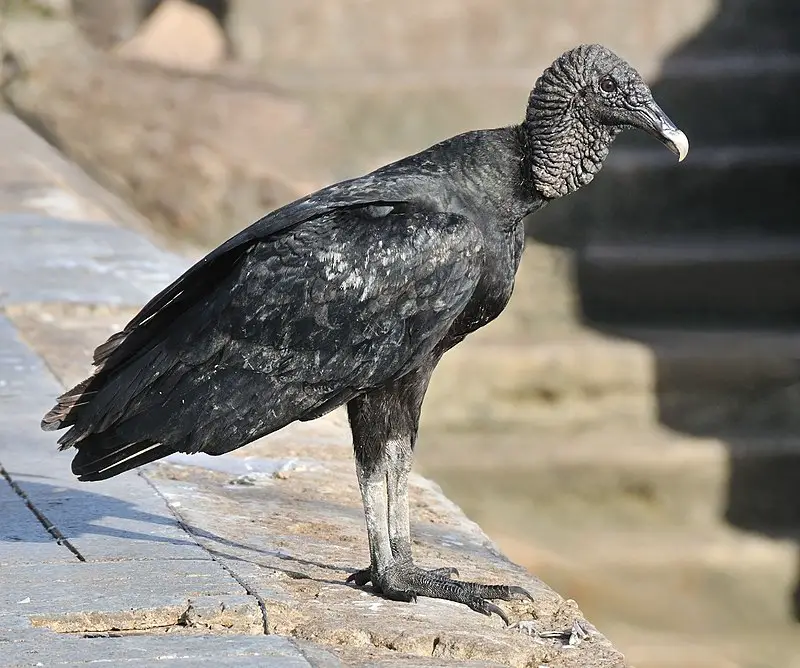
The black vulture is a widespread species of New World Vultures found in the northeastern United States to Peru, Central Chile, and Uruguay.
Its distinctive appearance has earned it many nicknames such as zopilote, urubu, or gallinazo.
This medium-sized bird has mainly black plumage with white markings on its wings and head and also features a long bill for scavenging carrion from carcasses.
Despite being able to fly up high due to its broad wingspan, it prefers keeping close to ground level when searching for food items like dead fish or small mammals available near human settlements.
As an apex predator, they play an important role in nature by helping keep their environment clean while providing other animals with sustenance through their leftovers.
Scientific classification:
| Kingdom | Animalia |
| Phylum | Chordata |
| Class | Aves |
| Order | Accipitriformes |
| Family | Cathartidae |
| Genus | Coragyps |
| Species | C. atratus |
Also Featured In: Most Common Birds Found in Chile, Birds You’ll Find in Zoo
17. Ruby-Throated Hummingbird
The ruby-throated hummingbird (Archilochus colubris) is a hummingbird species with an impressive migration pattern, spending the winter in Central America, Mexico, and Florida before flying to Canada and other parts of Eastern North America for the breeding season.
It’s the most common type seen east of the Mississippi River in North America.
Formally described by Swedish naturalist Carl Linnaeus in 1758, this tiny bird has bright metallic green upperparts with white underparts, a small black bill, and a red throat patch, which gives it its name; they measure around 3 inches long on average.
They feed primarily on nectar from flowers but eat insects such as flies or mosquitoes for extra protein during their migrations or when raising young chicks.
Scientific classification:
| Kingdom | Animalia |
| Phylum | Chordata |
| Class | Aves |
| Order | Apodiformes |
| Family | Trochilidae |
| Genus | Archilochus |
| Species | A. colubris |
Also Featured In: Georgia Birds, Autumn Birds You Should Know
18. Indigo Bunting
The Indigo Bunting is a small bird in the cardinal family throughout North and South America.
It has an unmistakable bright blue plumage that stands out against its natural habitat of farmland, brush areas, and open woodland.
During the breeding season, it can be seen from southern Canada to northern Florida, while during winter months, it migrates south towards Central and Northern South America.
The Indigo Bunting prefers to migrate at night using the stars as navigation aids.
This species feeds on insects and seeds they find near the ground or catch mid-flight with their agile wingspan.
An iconic sight for many farmers across both continents, these birds are a welcome addition to any backyard oasis or wildflower meadow.
Scientific classification:
| Kingdom | Animalia |
| Phylum | Chordata |
| Class | Aves |
| Order | Passeriformes |
| Family | Cardinalidae |
| Genus | Passerina |
| Species | P. cyanea |
Also Featured In: Birds that Live in Mississippi, Birds in Iowa Spring
19. Common Ground-Dove
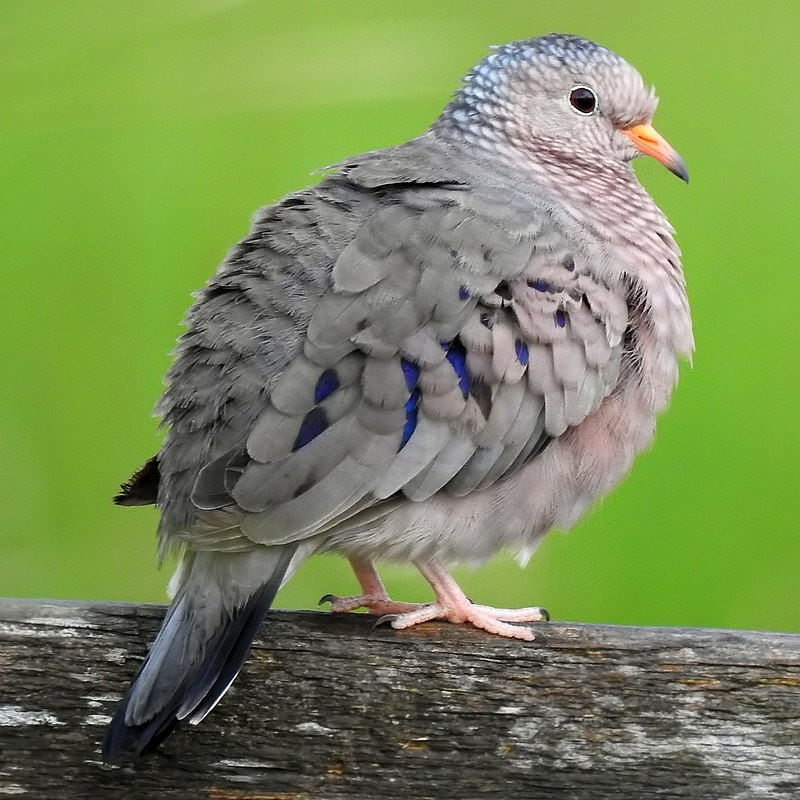
The Common Ground-Dove is a small bird found in the southern United States, Central America, the Caribbean, and northern South America.
It’s considered one of the smallest dove species in North America, with an average length of around 6–7 inches.
This ground-dwelling species spends most of its time on foot but has been known to fly when necessary or threatened.
The plumage is pale grayish brown above, while their bellies are white and speckled with black spots along their wings.
Its diet consists mainly of seeds from grasses and other low vegetation, which it forages for by walking slowly across open fields or lawns looking for food items like berries, grains, insects, spiders, and snails.
Scientific classification:
| Kingdom | Animalia |
| Phylum | Chordata |
| Class | Aves |
| Order | Columbiformes |
| Family | Columbidae |
| Genus | Columbina |
| Species | C. passerina |
Also Featured In: Barbados Birds, Birds You’ll Find in the Rio Grande Valley
20. Yellow-Crowned Night Heron
The Yellow-crowned night heron is a beautiful and unique bird species native to the Americas. It has distinctive yellow crowns on its head, making it easy to identify among other herons.
These birds are also larger than most other types of herons, reaching up to 70 cm in length and 850 g in weight.
They usually feed on small fish or crustaceans while wading through shallow waters with their long legs.
The yellow-crowned night heron can be found near marshes or lakes during the breeding season when they build nests made from twigs high above the ground for protection against predators like raccoons and foxes.
This majestic bird is an important part of wetland ecosystems as it helps balance populations of smaller aquatic animals by preying upon them.
Scientific classification:
| Kingdom | Animalia |
| Phylum | Chordata |
| Class | Aves |
| Order | Pelecaniformes |
| Family | Ardeidae |
| Genus | Nyctanassa |
| Species | N. violacea |
Also Featured In: Bermuda birds, Common Central Park Birds
21. Double-Crested Cormorant

The double-crested cormorant is a majestic bird with an impressive wingspan that spans North America from the Aleutian Islands down to Mexico.
Its black plumage stands out against its bright orange-yellow facial skin and some extended patches of white feathers on each side of its throat.
It measures 28 – 35 inches in length and has webbed feet that enable it to swim gracefully through rivers, lakes, and coastal areas.
These birds are known for their voracious appetite for fish, sometimes diving over 100 ft deep into water looking for food.
Despite this reputation, they feed on crustaceans, amphibians, and insects when available.
Cormorants have been part of many cultures throughout history due to their remarkable ability to fly long distances, making them valued messengers or companions during fishing expeditions at sea.
Scientific classification:
| Kingdom | Animalia |
| Phylum | Chordata |
| Class | Aves |
| Order | Suliformes |
| Family | Phalacrocoracidae |
| Genus | Nannopterum |
| Species | N. auritum |
Also Featured In: Cormorant Species, Water Birds Live around Us
22. Cliff Swallow
The Cliff swallow, or American cliff swallow (Petrochelidon pyrrhonota), is a passerine bird species belonging to the Hirundinidae family. They are commonly found in North and South America.
These birds have an unmistakable appearance with their bright orange foreheads and flame-colored backs, making them stand out from other swallows.
Cliff swallows form large colonies when nesting on cliffsides, making them very social creatures; they often feed together while flying around fields or rivers for insects to eat.
In addition, they use mud pellets to build cup-shaped nests under bridges and eaves of buildings near water sources such as lakes, rivers, and marshes – usually close to human dwellings.
Overall, these fascinating birds are both beautiful to look at and practical too — providing insect pest control services through feeding on flies and mosquitoes in return for humans’ protection – what could be better?
Scientific classification:
| Kingdom | Animalia |
| Phylum | Chordata |
| Class | Aves |
| Order | Passeriformes |
| Family | Hirundinidae |
| Genus | Petrochelidon |
| Species | P. pyrrhonota |
Also Featured In: Swallows Species, Blue Birds You’ll Found around Us
23. American Redstart
The American Redstart is a beautiful New World Warbler, first documented by Carl Linnaeus in 1758.
An elegant black and orange plumage sets it apart from other birds.
The genus Setophaga comes from the Ancient Greek words ‘sēs,’ meaning moth, and ‘pages,’ which means eating – referencing its insect-eating habits.
Its song is joyful, with short repeating phrases making up their melodic tune.
They are mostly found hopping around trees on their long legs during breeding season but migrate to Central America for winter months when food sources become scarce in North America.
Scientific classification:
| Kingdom | Animalia |
| Phylum | Chordata |
| Class | Aves |
| Order | Passeriformes |
| Family | Parulidae |
| Genus | Setophaga |
| Species | S. ruticilla |
Also Featured In: birds of Vermont, New Hampshire Birds You Should Know
24. Brown Pelican
The majestic brown pelican is a dive-feeding bird that belongs to the pelican family. It is one of the three pelican species in the Americas and is known to dive into water to catch its prey.
This bird can be found from the Atlantic Coast of New Jersey to the mouth of the Amazon River, along the Pacific Coast from British Columbia to northern Chile, including the Galapagos Islands.
Its scientific name is Pelecanus occidentalis, and it has a colored brown plumage, its distinct characteristic.
The brown pelican belongs to the largest bird species today, with a wingspan that can stretch up to seven feet long.
This bird helps maintain a balance in the ecosystem by eating smaller fish, crustaceans, and other aquatic prey.
Scientific classification:
| Kingdom | Animalia |
| Phylum | Chordata |
| Class | Aves |
| Order | Pelecaniformes |
| Family | Pelecanidae |
| Genus | Pelecanus |
| Species | P. occidentalis |
Also Featured In: Birds You’ll Find in the Sea, Flight Birds You Should Know
Conclusion
Biscayne Island in Biscayne Bay, Florida, is home to various bird species, including Brown Pelicans, Great Blue Herons, Ospreys, Laughing Gulls, and many more. The island’s rich avian population adds to its natural beauty and ecological significance.
It provides birdwatchers and nature enthusiasts ample opportunities to observe and appreciate these fascinating creatures in their natural habitat.